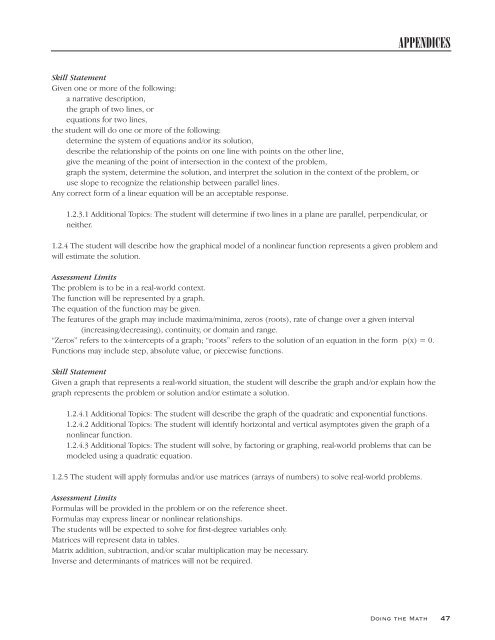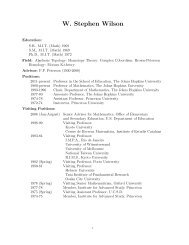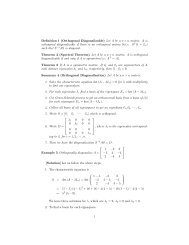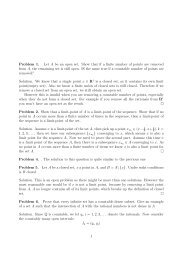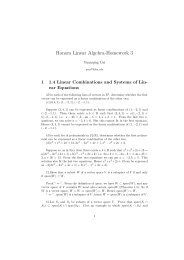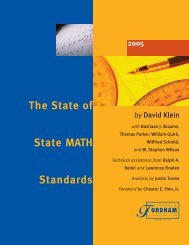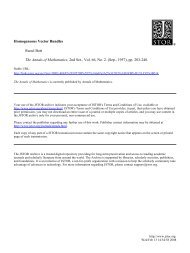Doing the Math - JHU Mathematics - Johns Hopkins University
Doing the Math - JHU Mathematics - Johns Hopkins University
Doing the Math - JHU Mathematics - Johns Hopkins University
You also want an ePaper? Increase the reach of your titles
YUMPU automatically turns print PDFs into web optimized ePapers that Google loves.
Skill Statement<br />
Given one or more of <strong>the</strong> following:<br />
a narrative description,<br />
<strong>the</strong> graph of two lines, or<br />
equations for two lines,<br />
<strong>the</strong> student will do one or more of <strong>the</strong> following:<br />
determine <strong>the</strong> system of equations and/or its solution,<br />
describe <strong>the</strong> relationship of <strong>the</strong> points on one line with points on <strong>the</strong> o<strong>the</strong>r line,<br />
give <strong>the</strong> meaning of <strong>the</strong> point of intersection in <strong>the</strong> context of <strong>the</strong> problem,<br />
graph <strong>the</strong> system, determine <strong>the</strong> solution, and interpret <strong>the</strong> solution in <strong>the</strong> context of <strong>the</strong> problem, or<br />
use slope to recognize <strong>the</strong> relationship between parallel lines.<br />
Any correct form of a linear equation will be an acceptable response.<br />
APPENDICES<br />
1.2.3.1 Additional Topics: The student will determine if two lines in a plane are parallel, perpendicular, or<br />
nei<strong>the</strong>r.<br />
1.2.4 The student will describe how <strong>the</strong> graphical model of a nonlinear function represents a given problem and<br />
will estimate <strong>the</strong> solution.<br />
Assessment Limits<br />
The problem is to be in a real-world context.<br />
The function will be represented by a graph.<br />
The equation of <strong>the</strong> function may be given.<br />
The features of <strong>the</strong> graph may include maxima/minima, zeros (roots), rate of change over a given interval<br />
(increasing/decreasing), continuity, or domain and range.<br />
“Zeros” refers to <strong>the</strong> x-intercepts of a graph; “roots” refers to <strong>the</strong> solution of an equation in <strong>the</strong> form p(x) = 0.<br />
Functions may include step, absolute value, or piecewise functions.<br />
Skill Statement<br />
Given a graph that represents a real-world situation, <strong>the</strong> student will describe <strong>the</strong> graph and/or explain how <strong>the</strong><br />
graph represents <strong>the</strong> problem or solution and/or estimate a solution.<br />
1.2.4.1 Additional Topics: The student will describe <strong>the</strong> graph of <strong>the</strong> quadratic and exponential functions.<br />
1.2.4.2 Additional Topics: The student will identify horizontal and vertical asymptotes given <strong>the</strong> graph of a<br />
nonlinear function.<br />
1.2.4.3 Additional Topics: The student will solve, by factoring or graphing, real-world problems that can be<br />
modeled using a quadratic equation.<br />
1.2.5 The student will apply formulas and/or use matrices (arrays of numbers) to solve real-world problems.<br />
Assessment Limits<br />
Formulas will be provided in <strong>the</strong> problem or on <strong>the</strong> reference sheet.<br />
Formulas may express linear or nonlinear relationships.<br />
The students will be expected to solve for first-degree variables only.<br />
Matrices will represent data in tables.<br />
Matrix addition, subtraction, and/or scalar multiplication may be necessary.<br />
Inverse and determinants of matrices will not be required.<br />
<strong>Doing</strong> <strong>the</strong> <strong>Math</strong> 47


